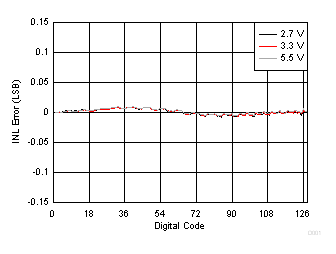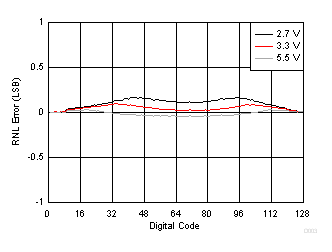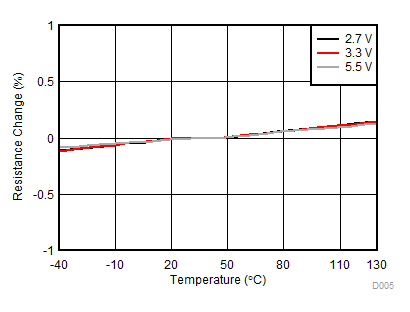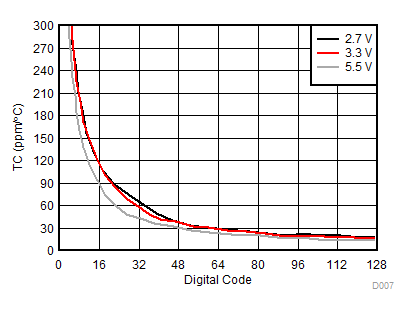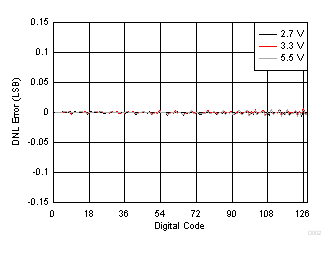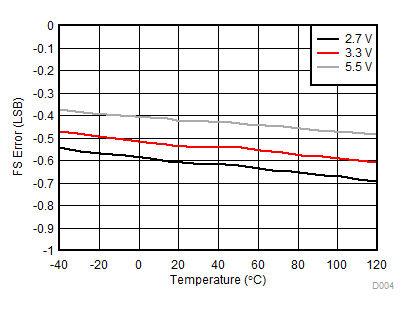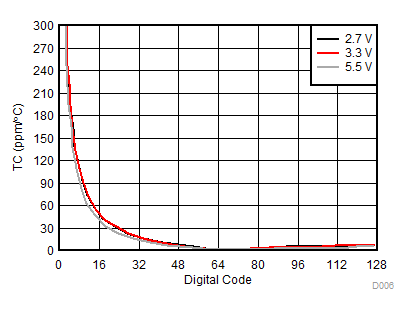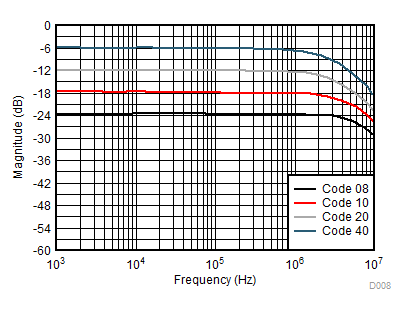ZHCSFW3 November 2016 TPL0401A-10-Q1 , TPL0401B-10-Q1
PRODUCTION DATA.
- 1 特性
- 2 应用
- 3 说明
- 4 修订历史记录
- 5 Device Comparison Table
- 6 Pin Configuration and Functions
- 7 Specifications
- 8 Parameter Measurement Information
- 9 Detailed Description
- 10Application and Implementation
- 11Power Supply Recommendations
- 12Layout
- 13器件和文档支持
- 14机械、封装和可订购信息
7 Specifications
7.1 Absolute Maximum Ratings
over operating free-air temperature range (unless otherwise noted) (1)| MIN | MAX | UNIT | |||
|---|---|---|---|---|---|
| VDD | Supply voltage | VDD to GND | –0.3 | 7 | V |
| IH, IL, IW | Continuous current | ±5 | mA | ||
| VI | Digital input pins (SDA, SCL) | –0.3 | VDD + 0.3 | V | |
| Potentiometer pins (H, W) | –0.3 | VDD + 0.3 | |||
| TJ(MAX) | Maximum junction temperature | 130 | °C | ||
| Tstg | Storage temperature | –65 | 150 | °C | |
(1) Stresses beyond those listed under Absolute Maximum Ratings may cause permanent damage to the device. These are stress ratings only, which do not imply functional operation of the device at these or any other conditions beyond those indicated under Recommended Operating Conditions. Exposure to absolute-maximum-rated conditions for extended periods may affect device reliability.
7.2 ESD Ratings
| VALUE | UNIT | |||
|---|---|---|---|---|
| V(ESD) | Electrostatic discharge | Human-body model (HBM), per AEC Q100-002(1) | ±2500 | V |
| Charged-device model (CDM), per AEC Q100-011 | ±1000 | |||
(1) AEC Q100-002 indicates that HBM stressing shall be in accordance with the ANSI/ESDA/JEDEC JS-001 specification.
7.3 Recommended Operating Conditions
over operating free-air temperature range (unless otherwise noted)| MIN | MAX | UNIT | ||
|---|---|---|---|---|
| VDD | Supply voltage | 2.7 | 5.5 | V |
| VW,VH, SDA, SCL | Terminal voltage | 0 | VDD | V |
| VIH | Voltage input high ( SCL, SDA ) | 0.7 × VDD | VDD | V |
| VIL | Voltage input low ( SCL, SDA ) | 0 | 0.3 × VDD | V |
| IW | Wiper current | –2 | 2 | mA |
| TA | Ambient operating temperature | –40 | 125 | °C |
7.4 Thermal Information
| THERMAL METRIC(1) | TPL0401x-10-Q1 | UNIT | |
|---|---|---|---|
| DCK (SC70) | |||
| 6 PINS | |||
| RθJA | Junction-to-ambient thermal resistance | 234 | °C/W |
| RθJC(top) | Junction-to-case (top) thermal resistance | 110.5 | °C/W |
| RθJB | Junction-to-board thermal resistance | 79 | °C/W |
| ψJT | Junction-to-top characterization parameter | 7.2 | °C/W |
| ψJB | Junction-to-board characterization parameter | 77 | °C/W |
| RθJC(bot) | Junction-to-case (bottom) thermal resistance | N/A | °C/W |
(1) For more information about traditional and new thermal metrics, see the Semiconductor and IC Package Thermal Metrics application report.
7.5 Electrical Characteristics
Typical values are specified at 25°C and VDD = 3.3 V (unless otherwise noted)| PARAMETER | TEST CONDITIONS | MIN | TYP | MAX | UNIT | ||
|---|---|---|---|---|---|---|---|
| RTOTAL | End-to-end resistance | 8 | 10 | 12 | kΩ | ||
| RH | Terminal resistance | 100 | 200 | Ω | |||
| RW | Wiper resistance | 35 | 100 | Ω | |||
| CH | Terminal capacitance | 10 | pF | ||||
| CW | Wiper capacitance | 11 | pF | ||||
| TCR | Resistance temperature coefficient | 22 | ppm/°C | ||||
| IDD(STBY) | VDD standby current | –40°C to +105°C | 0.5 | µA | |||
| –40°C to +125°C | 1.5 | ||||||
| IIN-DIG | Digital pins leakage current (SCL, SDA Inputs) | –2.5 | 2.5 | µA | |||
| SERIAL INTERFACE SPECS (SDA, SCL) | |||||||
| VIH | Input high voltage | 0.7 × VDD | VDD | V | |||
| VIL | Input low voltage | 0 | 0.3 × VDD | V | |||
| VOL | Output low voltage | SDA Pin, IOL = 4 mA | 0.4 | V | |||
| CIN | Pin capacitance | SCL, SDA Inputs | 7 | pF | |||
| VOLTAGE DIVIDER MODE (VH = VDD, VW = Not Loaded) | |||||||
| INL(3)(1) | Integral non-linearity | –0.5 | 0.5 | LSB | |||
| DNL(4)(1) | Differential non-linearity | –0.25 | 0.25 | LSB | |||
| ZSERROR(5)(2) | Zero-scale error | 0 | 0.75 | 1.5 | LSB | ||
| FSERROR(6)(2) | Full-scale error | –1.5 | –0.75 | 0 | LSB | ||
| TCV | Ratiometric temperature coefficient | Wiper set at mid-scale | 4 | ppm/°C | |||
| BW | Bandwidth | Wiper set at mid-scale, CLOAD = 10 pF |
2862 | kHz | |||
| TSW | Wiper settling time | See Figure 10 | 0.152 | µs | |||
| THD+N | Total harmonic distortion | VH = 1 VRMS at 1 kHz, measurement at W |
0.03 | % | |||
| RHEOSTAT MODE (VH = VDD, VW = Not Loaded) | |||||||
| RINL(9)(7) | Rheostat mode integral non-linearity | –1 | 1 | LSB | |||
| RDNL(10)(7) | Rheostat mode differential non-linearity | 0.5 | 0.5 | LSB | |||
| ROFFSET(11)(8) | Rheostat-mode zero-scale error | 0 | 0.75 | 2 | LSB | ||
(1) LSB = (VMEAS[code 127] – VMEAS[code 0]) / 127
(2) IDEAL_LSB = VH/ 128
(3) INL = ((VMEAS[code x] – VMEAS[code 0]) / LSB) – [code x]
(4) DNL = ((VMEAS[code x] – VMEAS[code x-1]) / LSB) – 1
(5) ZSERROR = VMEAS[code 0] / IDEAL_LSB
(6) FSERROR = [(VMEAS[code 127] – VH) / IDEAL_LSB] + 1
(7) RLSB = (RMEAS[code 127] – RMEAS[code 0]) / 127
(8) IDEAL_RLSB = RTOT / 128
(9) RINL = ( (RMEAS[code x] – RMEAS[code 0]) / RLSB) – [code x]
(10) RDNL = ( (RMEAS[code x] – RMEAS[code x–1]) / RLSB ) – 1
(11) ROFFSET = RMEAS[code 0] / IDEAL_RLSB
7.6 Timing Requirements
| MIN | MAX | UNIT | ||
|---|---|---|---|---|
| STANDARD MODE | ||||
| fSCL | I2C Clock frequency | 0 | 100 | kHz |
| tSCH | I2C Clock high time | 4 | µs | |
| tSCL | I2C Clock low time | 4.7 | µs | |
| tsp | I2C Spike time | 0 | 50 | ns |
| tSDS | I2C Serial data setup time | 250 | ns | |
| tSDH | I2C Serial data hold time | 0 | ns | |
| tICR | I2C Input rise time | 1000 | ns | |
| tICF | I2C Input fall time | 300 | ns | |
| tOCF | I2C Output fall time, 10 pF to 400 pF bus | 300 | ns | |
| tBUF | I2C Bus free time between stop and start | 4.7 | µs | |
| tSTS | I2C Start or repeater start condition setup time | 4.7 | µs | |
| tSTH | I2C Start or repeater start condition hold time | 4 | µs | |
| tSPS | I2C Stop condition setup time | 4 | µs | |
| tVD(DATA) | Valid data time, SCL low to SDA output valid | 1 | µs | |
| tVD(ACK) | Valid data time of ACK condition, ACK signal from SCL low to SDA (out) low | 1 | µs | |
| FAST MODE | ||||
| fSCL | I2C Clock frequency | 0 | 400 | kHz |
| tSCH | I2C Clock high time | 0.6 | µs | |
| tSCL | I2C Clock low time | 1.3 | µs | |
| tsp | I2C Spike time | 0 | 50 | ns |
| tSDS | I2C Serial data setup time | 100 | ns | |
| tSDH | I2C Serial data hold time | 0 | ns | |
| tICR | I2C Input rise time | 20 | 300 | ns |
| tICF | I2C Input fall time | 20 × (VDD / 5.5) | 300 | ns |
| tOCF | I2C Output fall time, 10 pF to 400 pF bus | (VDD / 5.5) × 20 | 300 | ns |
| tBUF | I2C Bus free time between stop and start | 1.3 | µs | |
| tSTS | I2C Start or repeater start condition setup time | 1.3 | µs | |
| tSTH | I2C Start or repeater start condition hold time | 0.6 | µs | |
| tSPS | I2C Stop condition setup time | 0.6 | µs | |
| tVD(DATA) | Valid data time, SCL low to SDA output valid | 1 | µs | |
| tVD(ACK) | Valid data time of ACK condition, ACK signal from SCL low to SDA (out) low | 1 | µs | |
7.7 Typical Characteristics
